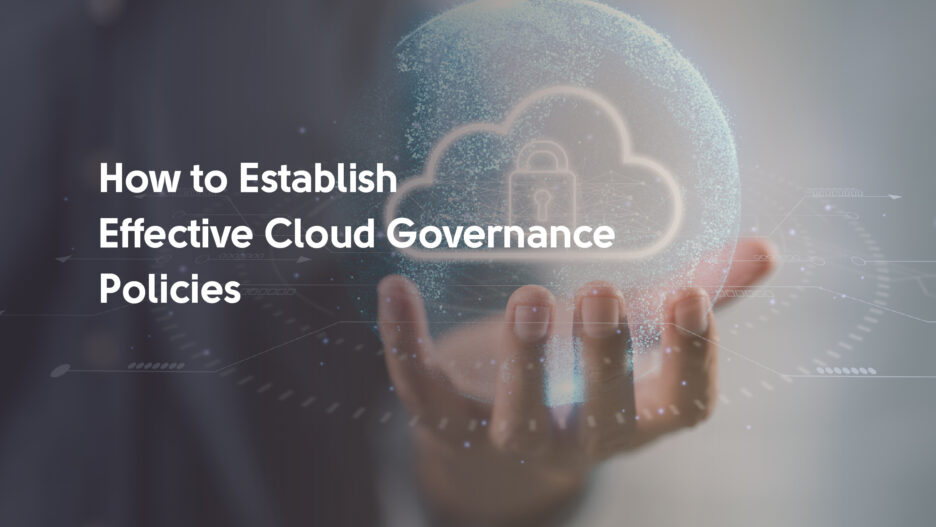If your organization is among cloud adopters, you already understand the benefits and the challenges of this technology. Virtually limitless scalability and instant resource provisioning may come with a high price tag. Cloud data storage enables seamless collaboration and advanced data analytics scenarios, but also increases security risks.
To maximize the value of the cloud, mature companies invest as much in the technology as they do in establishing an effective cloud governance model.
What is Cloud Governance?
Cloud governance is the processing of defining, implementing, and monitoring appropriate practices for ensuring effective, secure, and cost-effective cloud operations. Structured as a collection of policies, a cloud governance framework establishes roles, responsibilities, and controls for using cloud infrastructure, data storage, and applications.
Effective cloud governance helps optimize cloud resource usage, maximize infrastructure performance, mitigate compliance and security risks, plus align cloud technology usage with the overarching business and IT strategies.
Given that 89% of businesses now rely on a multi-cloud strategy, having comprehensive cloud governance and compliance is critical for achieving cost-effectiveness in the areas of data management, data security, risk management, and business continuity — and ensuring that all these processes work well together to meet your business goals.
Key Principles of Cloud Governance
A cloud governance model consists of six functional areas, governed by respective practices, principles, and policies.
Although each area has separate main objectives, they’re often mutually dependent, influencing and sometimes constraining one another. For example, cloud data governance and cloud security governance are tightly connected areas: You cannot achieve cloud security without ensuring effective data management. Performance management influences cloud cost governance as higher resource availability often comes with increased spending.
Good cloud governance can be summarized as follows:
| Principle | Description |
| Financial management (FinOps) |
Cloud overspending is rampant, yet oftentimes avoidable. FinOps promotes collaboration between finance, technology, and business teams to establish appropriate guardrails for financial accountability, cost efficiency, and value realization. The goal of FinOps is to establish a viable cloud cost model for the company — such that doesn’t hinder innovation and curbs overspending. |
| Operations management (CloudOps) |
Similar to how DevOps optimizes application development processes, CloudOps brings extra standardization into the provisioning, tuning, and performance optimization of cloud workloads and cloud services. The goal of CloudOps is to ensure the reliable, scalable, and efficient provisioning of cloud resources, while also optimizing utilization rates. |
| Security and compliance management (SecOps) |
Cloud security governance is critical to prevent data breaches (and subsequent compliance fines). SecOps promotes tighter collaboration between cybersecurity and IT operations teams to establish tight, uniform cybersecurity protection across the entire IT estate. Establishing an effective cloud security posture management (CSPM) process promotes faster threat detection, timely vulnerability detection, and complete visibility into public, private, and hybrid cloud infrastructure for auditory purposes. |
| Data management | Data governance in the cloud is vital for accelerating big data analytics, as well as ensuring tight security and ethical use. A good cloud data governance framework
establishes a full lifecycle of data in your organization, covering data collection, storage, security, and analytics. It incorporates essential practices like data classification, data backup and disaster recovery, data portability, and data monitoring, and encourages automation of most data-related processes for greater visibility and efficiency. |
| Performance management |
Cloud performance management is necessary to deliver expected levels of IT services and efficiently utilize cloud infrastructure. Practices like continuous infrastructure and application monitoring must be in place to ensure high infrastructure availability and prudent cloud spending. |
| Asset and configuration management |
In large (multi-)cloud estates, configuration management becomes a time-consuming and error-prone process. Hence, you need processes for maintaining an up-to-date inventory of all cloud-based resources and recommended configurations for them to quickly identify issues that may affect costs, security, or compliance. Asset governance in the cloud establishes automated practices for tracking resource ownership, and usage. Infrastructure is to use infrastructure as code (IaC) solutions, in turn, help enforce consistency with the established policies. |
How to Establish Effective Cloud Governance Policies
Right-sized governance policies are crucial for maximizing the ROI of cloud adoption. Without proper guardrails in place, you’re missing out on opportunities to consolidate resources, secure workloads, and fine-tune performance in the most critical areas. To take better control of your cloud estate, we recommend the following approach:
Conduct a Cloud Asset Discovery
Over half of business leaders (54%) believe that the primary waste of cloud resources is low visibility. Indeed, with multiple cloud service providers (CSPs) and a grand array of auxiliary cloud services in their portfolios, some resources can remain outside of direct purview and thus control. Lack of visibility also negatively affects cloud security since poorly protected storage buckets and virtual machines (VMs) with expired software can be leveraged as entryways by hackers.
Thus, the first step in establishing cloud compliance and governance should be cloud asset discovery. You’ll need to create a complete catalog of all cloud assets across compute, storage, and big data analytics.
The good news is that asset discovery can be done automatically, using cloud governance tools from cloud services providers (CSPs):
- AWS Resource Explorer helps discover AWS resources across accounts and regions from a single interface, based on assigned names, tags, or other attributes. AWS Config, in turn, provides resource configuration history, tracks changes, and helps implement new infrastructure configuration controls to ensure compliance with internal policies or external regulations.
- Azure Resource Manager provides a management layer for provisioning, updating, deleting, and securing cloud resources, using available templates or custom rules. Azure Resource Graph is a complementary service that provides robust querying capabilities for auditing all resources across your subscriptions and verifying the application of cloud policies.
- Cloud Asset Inventory service provides full visibility into your entire infrastructure on Google Cloud and Athons, covering popular services like Cloud SQL, Cloud Storage, Google Kubernetes Engine, and Compute Engine. You can aggregate the current policies, review historical configurations, and set up continuous monitoring.
The above tools help create a full catalog of in-use resources, establish their ownership, and current usage scenarios. A quick sweep can help reveal gaps in your taxonomies and identify potential cloud risks.
Using the obtained data, establish recommended configurations for different groups of cloud resources, covering identity and access management (IAM), security, compliance, and performance requirements.
Use extra cybersecurity services like Microsoft Defender for Cloud on Azure or AWS GuardDuty to discover potential risks and build a catalog of them to form cloud governance best practices. Focus on mitigating risks that affect the entire infrastructure, rather than individual workloads first. Then move on to securing the remaining workloads and applications, which require custom policies.
Formulate Cloud Governance Policies
Cloud governance policies are a set of rules and guidelines in place for controlling cloud computing environments. Separate policies are created for different elements of cloud governance:
- Cloud migration
- Cloud-based data governance
- Access control
- Performance management
- Cost control
- Security and Compliance
Each policy needs a clear scope. Clearly define which services, regions, environments, and workloads are subject to this policy. Explain how the new policies will affect different roles and how the accountability changes.
Be explicit about responsibilities. Define which roles are in charge of the policy implementation, enforcement, and monitoring and how the changes will affect different teams. For example, cloud application developers are responsible for the application code and are bound to adhere to the CloudOps, asset, and configuration management policies. Cloud engineers, in turn, are in charge of infrastructure deployment, configuration, performance optimization, and fine-tuning.
Different cloud engineering teams may be responsible for different workloads or cloud platforms. In a hybrid cloud governance scenario, for example, you’ll need separate IT operations teams to support cloud and on-premises environments. Similarly, people with different skills are required to lead Azure and AWS cloud governance programs.
Include feedback mechanisms. The initial controls may create new performance bottlenecks or, on the contrary, increase cloud spending. Establish methods for collecting feedback about cloud governance policies to ensure better strategy alignment and minimize cases of policy violations.
Enforce New Cloud Governance Policies
Policies are only effective when they’re followed. Soundly, CSPs provide an arsenal of cloud governance solutions that automate policy deployment and compliance.
For Azure, the primary tool for enforcing cloud governance is Azure Policy — a service for implementing fine-grained controls across all cloud resource groups and monitoring policy enforcement in real time.
Azure Policy offers pre-defined templates for resource tagging, cost management, and security configurations, as well as the ability to define custom policies using JSON. All policies can be then assigned to specific scopes (e.g., resource groups or individual workloads) from one dashboard. Afterward, the tool will analyze all resource configurations and provide a compliance report, monitoring the resources' ongoing statuses in real-time.
You can also enforce extra Azure cloud governance best practices via ancillary services like
Microsoft Defender for Cloud (for cloud security posture management), Microsoft Purview (for cloud data governance), Azure Monitor (for operations and resource management), and Microsoft Entra ID Governance (for identity and access management).
On AWS, the AWS Config service helps implement and scale cloud governance policies. Similar to Azure Policy, AWS Config provides pre-built frameworks for compliance with different best practices and an option to add custom ones using AWS Lambda functions. It also tracks the configuration of AWS resources, maps relationships between different resource groups, and provides status reports.
For more granular controls, you can also use AWS Organizations' Service Control Policies (SCPs) tool, which helps define and enforce permissions for different IAM roles. You can create policies on an account, unit, or resource level and explicitly define which actions are allowed. Other helpful tools include:
- AWS Security Hub runs automated security checks across your cloud estate to identify deviations from established policies.
- AWS Glue Data Catalog helps create a centralized metadata repository to improve cloud data discoverability, lineage tracking, and cataloging.Â
- Amazon CloudWatch provides observability and monitoring, helping ensure more effective asset management and performance optimization.
- AWS Identity Center offers centralized identity management and governance features.
The majority of cloud governance and compliance policies can be automatically enforced. In edge cases, you can create manual checklists and distribute these among your teams to verify the correct policy application.
Monitor Cloud Governance
Monitoring is critical for tracking your progress against the initial baseline. Likewise, audit reports are necessary for external compliance with regulations like HIPAA and FERPA in the healthcare industry, PCI DSS in the financial sector, as well as cross-sector regulations like GDPR, CCPA, and EU-U.S. Data Privacy Framework.
Tools like Azure Policy and AWS Config provide real-time monitoring dashboards for checkbox compliance. Additionally, you can collect and analyze extra logs to better understand the coverage and impacts of implemented cloud governance policies. These include:
- User Activity and access logs to detect unauthorized access attempts and maintain visibility into configuration changes.
- Security and compliance logs to proactively identify cloud threats and vulnerabilities and enforce cloud security governance.
- Â Network and traffic logs to optimize network performance and troubleshoot connectivity issues.
- Database and storage logs to detect unauthorized access, analyze database performance, and preserve data integrity.
- Cost and usage logs to monitor cloud spending, optimize budgets, and ensure financial transparency.
Finally, regularly review your cloud governance policies and introduce changes based on the workforce feedback, new technology acquisitions, and changes in the business strategy.
To Conclude
Cloud computing has ignited innovations in business models and remains a springboard for further advancements in big data analytics, artificial intelligence, and IoT deployments among other areas. However, without appropriate cloud governance policies, your cloud infrastructure can easily become a liability, instead of a catalyst for innovation. Investing in the above steps is thus critical to prevent cloud overspending, security breaches, unplanned downtime, and regulatory non-compliance.
Svitla Systems cloud engineering team would be delighted to evaluate your cloud governance posture and implement the optimal strategies for advancing your cloud maturity. Contact us for a consultation.





